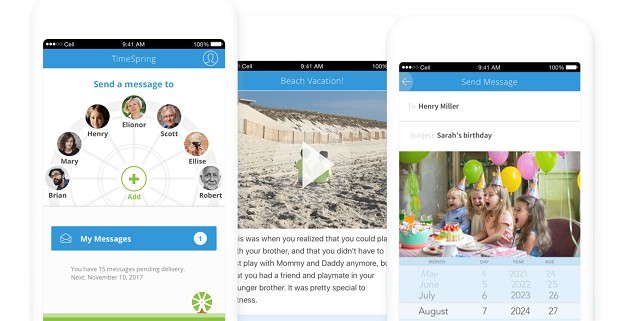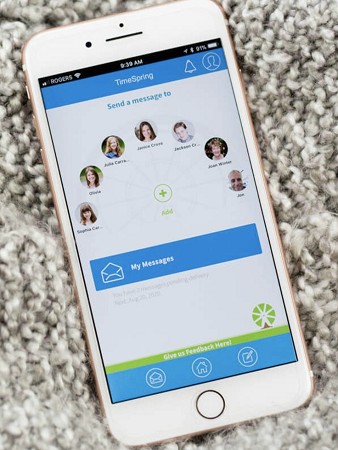* – This article has been archived and is no longer updated by our editorial team –
TimeSpring is a social platform that enables time-released messaging, so one can take a photo or video today, and instead of sending it to someone in real time they can schedule it to be delivered to someone at a date in the future. This allows people to not only share in different time frames, but with future generations.
Below is our recent interview with Felice Bernard, the Founder of TimeSpring:

Q: Could you tell us something more about time-released messaging?
A: With time-released messaging, parents and grandparents can send messages to children by creating accounts for them and saving these messages for when a child is mature enough understand and appreciate the story behind a photo.
With this growing trend of thinking critically about the future people are using TimeSpring in myriad of ways: Parents are sending memories to children, friends, and spouses. Grandparents who are becoming increasingly more tech savvy are sending messages to their grown children and grandchildren. For people who are unfortunate to have a terminal illness, TimeSpring provides the security of leaving behind a legacy for those that they love, and gives time for those who are so cheated by it. Many users of all ages enjoy sending messages to their future selves whether it be for weight loss purposes or tracking goals and ambitions; there are many reasons to send a time-released message.
It’s quite remarkable how time appreciates that value of our memories. You look back on a photo from five years ago, and we pause and say, “Where did the time go?” This is only magnified when you witness how fast children grow. What makes TimeSpring so special is adding the element of time to the equation. Even an everyday memory like your Dad taking a video of you brushing your teeth before bed, sent with a note, and scheduled ten years forward, upon receipt, that memory has value, and if that father is no longer alive, well then, that message is now priceless.
 Recommended: Portfolio And Tax Manager For Cryptocurrencies CoinTracker Announces $1.5 Million In Seed Funding Round
Recommended: Portfolio And Tax Manager For Cryptocurrencies CoinTracker Announces $1.5 Million In Seed Funding Round
Q: How exactly does it work?
A: The process behind the app is simple: Users install it for free, fill their TimeSpring wheel with friends, family, and children. Once you fill your TimeSpring wheel, and start sending your future messages! Just like sending an e-mail, you attach photos or videos, write a note, tell the story behind the photos, and schedule a delivery date up to 30 years into the future. If it is a child you are sending to, leave the e-mail blank and it can be activated when they are old enough. At any point in time you can edit profiles, e-mail addresses, and of course, delivery dates.
When you send a message, we store it, and your memory will unlock at the time that you prescribe, and at that point the recipient of the message will be notified that they’ve received a TimeSpring message.
Q: Can you give us insights into your features?
A: Our main feature and focus at TimeSpring is time-released technology. From saving a family recipe to sharing wisdom, the sky is the limit when thinking of reasons to send a time-released message.
Here are our most popular types of TimeSpring messages:
· Parent to child: Document their childhood through your eyes, share wisdom, stories, and of course photos with children at special times and milestones in their life.
· Grandparent to grandchild: Ensure that these special times with grandchildren are remembered as you can strengthen the bond between grandparent and grandchild.
· Send-to-self: Using our send-to-self feature, send your ‘future self’ a quick note whether it’s a reminder of a goal that you want to accomplish, or a quote that you found inspirational at the time.
· Posthumous messaging: A scheduled message remains a scheduled message
whether you’re here or departed. For some, especially those suffering with a terminal illness, that’s a very comforting thought as coping with the loss of someone you love is universally challenging and leaving a legacy becomes more important as you are threatened by time.
Q: How would you convince the reader to start using TimeSpring?
A: Sharing in real-time has become a vital part of our daily lives, but future-sharing is, well, the future. What we post today online, whether it’s a picture of avocado toast or a high school graduation, the insignificant and the significant all have a very long digital life online; why not make sure that the important memories last? And let’s make sure that that they last long enough so that the most important people in our lives get to enjoy them too.
Realistically, the way we capture our lives these days with cell phones, makes it very challenging and save anything long-term, and even harder to save for the next generation to enjoy. TimeSpring is an easy solution for this. Passing down photos and memories has long been a part of the human experience; yet, surprisingly, there’s been little technological advancement to make sending a message to the future possible, until TimeSpring. We say, give it a try—the feeling you get when upon crafting your first message will have you convinced.
 Recommended: CargoX Is Reshaping International Logistics With A Blockchain-Based Platform
Recommended: CargoX Is Reshaping International Logistics With A Blockchain-Based Platform
Q: What are your plans for the future?
A: Our whole business is about looking toward the future, and we have some very excited features and updates coming down the pipeline. One feature that has been quite the conversation starter has been—“to know or not to know”? That is, if someone has sent you a TimeSpring message would you like to know when it’s coming or would you like to be surprised? What if that message is coming in ten years? Would you still want to know that a message is being stored waiting for you or would you prefer to not know if it’s existence? Some say “yes”–others, “no”.
Predictably, this conversation is heightened in scenarios of posthumous messages: If a loved one who has passed has scheduled messages for you, would you like to know when they’re coming? We’ve found time and time again that it is a polarizing discussion, and we say, why choose? Therefore, we have plans enable a setting that can be turned off and on for those who would like to know when messages are coming and for those who would prefer not to know.

